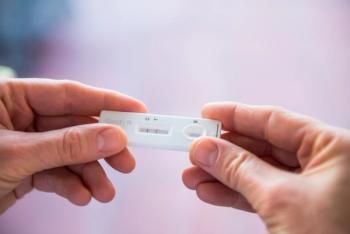
Improved Quality of Life from Sacral Nerve Stimulation for Treatment of Urinary Urge Incontinence
Study Links Clinical Benefits of Sacral Nerve Stimulation for Treatment of Urinary Urge Incontinence to Improved Quality of Life
ANAHEIM, Calif.–– June 5, 2001 –– A study presented here at the 96th annual meeting of the American Urological Association (AUA) confirms that sacral nerve stimulation is an effective treatment for severe bladder control problems and has a positive effect on patients’ quality of life. Specifically, the findings revealed that patients’ ability to empty their bladders more effectively correlates with an increase in their quality of life.
Researchers investigating the success and impact of sacral nerve stimulation on quality of life used InterStim® Therapy for Urinary Control from Medtronic, Inc. InterStim Therapy delivers mild electrical impulses to the sacral nerves with an implantable medical device akin to a cardiac pacemaker. The sacral nerves, located at the base of the spinal cord in the lower back, influence bladder function.
"Several past articles report clinical success of sacral nerve stimulation as a treatment for bladder control problems, but only a few consider its effects on a patient’s quality of life after the device has been implanted," said Francesco Cappellano, M.D., a urologist at Policlinico Multispecialistico Multimedica in Milan, Italy, and the lead author of the study, “Quality-of-Life Assessment in Patients [Who] Underwent Sacral Neuromodulation Implant for Urge Incontinence." "The positive outcomes demonstrated in this study confirm quality-of-life analysis as an additional tool to evaluate the effectiveness of sacral nerve stimulation, enabling us to better understand the impact of therapy on patients’ lives."
The study comprised 56 patients (42 female, 14 male; mean age 55±12) who did not respond favorably to previous treatment and underwent the implantation of a Medtronic neurostimulator that delivers InterStim Therapy. Patients suffering from urge incontinence due to detrusor instability (41 patients), hyperreflexia (11 patients) or urgency frequency (4 patients) were asked to fill out a self-reported, quality-of-life questionnaire before the implant and three, six, nine, 12, 18, 24 and 36 months afterward.
Results indicate a strong correlation between the number of incontinent episodes and a quality-of-life index. The average number of daily incontinent episodes for patients with detrusor instability decreased from 5.5 pre-implant to 1.1 at 12 months, while patients with hyperreflexia experienced a decrease from 6.8 pre-implant to 1.5 at eight months.
Quality-of-life measurements were based on a validated 22-item questionnaire specifically developed for this study and a patient diary completed before and after the implant at established intervals. Both were analyzed to determine the quality-of-life index –– a score ranging from zero (poor self-perceived quality of life due to incontinence) to 100 (incontinence did not negatively impact quality of life).
The detrusor instability patient group’s score increased from 33.1 at baseline to 74.7, 80.5, 69.6 and 73.7, respectively, at the three-, six-, 12- and 18-month follow-ups (p<0.001). Patients suffering from hyperreflexia reported a score increase from 38.2 before implant to 66 at the three-month follow-up and to 76 at the six-month follow-up (p<0.03). Finally, the urgency frequency patients experienced a quality of life increase from 40 at pre-implant to 73 at three months, 66 at six months and 60.5 at 12 months (p=n.s.).
When asked if they would opt to receive the therapy again at the three-month follow-up, 93 percent of patients responded affirmatively, while 96 percent indicated that they would recommend it to a relative or a friend suffering from a similar condition. When asked the same question again at the 18-month follow-up, 90 percent of patients responded affirmatively, and 100 percent said they would recommend the treatment.
As many as 20 million Americans suffer from bladder control problems, and the vast majority –– about 85 percent –– are women between the ages of 30 and 59. Medtronic estimates that tens of thousands of properly selected patients with these conditions could benefit from InterStim Therapy, which is approved as a treatment for urinary urge incontinence, significant symptoms of urgency-frequency, and nonobstructive urinary retention.
Combined, urinary urge incontinence, a chronic condition characterized by the sudden and strong urge to urinate followed by the involuntary loss of urine, and urgency-frequency syndrome, which repeatedly triggers an urgent need to urinate, affect more than 17 million Americans. Urinary retention, an inability to empty the bladder completely or at all, afflicts about 1.7 million people in the United States and can lead to secondary health risks, including urinary tract damage and infection, overflow incontinence and reflux.
In addition to physical health implications, urge incontinence patients often suffer from poor quality of life including a loss of self-esteem, sleep deprivation, symptoms of depression, embarrassment and even financial distress. In severe cases, individuals may no longer be able to work, ultimately increasing the economic burden associated with treatment costs. A 1995 estimate indicated that the direct costs for urinary incontinence (such as initial diagnostic and medical evaluation, costs of treatment, and extended use of disposable medical supplies such as absorbent pads and urinary collection devices) were $26.3 billion for individuals at least 65 years of age (which translated to $3,565 per individual with urinary incontinence).
According to an analysis from an insurance claims database in Minnesota also presented here at the AUA meeting, three percent of insured members within the health plan had claims evidence of voiding dysfunction –– the inability to empty urine from the bladder. Health care costs for these patients represent a considerable expense totaling $91.5 million. Hospitalizations accounted for 59 percent of voiding expenditures, outpatient/office visits for 24 percent, and outpatient pharmacy for nine percent. The remaining eight percent was expended on emergency room and other miscellaneous services. The analysis, conducted by a team from the Allina Health System in Minneapolis, was led by Douglas F. Milam, M.D.
For tens of thousands of patients who suffer from bladder control problems, firstline treatments such as medication, biofeedback and pelvic floor exercises fail to relieve the symptoms adequately. Patients are challenged by limited treatment options, accompanied by high costs and limited symptom relief. Drug therapies have reported cure rates of less than 45 percent and are often associated with side effects, while surgical treatments such as bladder augmentations, bladder removals or urinary diversions are irreversible and often lead to complication rates ranging from three percent to 15 percent depending on the procedure.
Before the introduction of InterStim Therapy in the late 1990s, these patients’ options were mainly limited to irreversible bladder surgery or a lifetime of absorbent pads or self-catheterization. Since then, approximately 4,000 people worldwide have received InterStim Therapy.
InterStim Therapy first received FDA approval in September 1997 for the treatment of urinary urge incontinence. In April 1999, it was approved to treat significant symptoms of urgency-frequency and nonobstructive urinary retention.
The Interstitial Cystitis Association (ICA), based in Rockville, Maryland, is a not-for-profit voluntary health agency, dedicated to providing support and information to patients, education of the lay and medical communities, and promotion and funding for IC research. In existence since 1984, the ICA has funded more than $1,000,000 in research. The ICA’s leadership includes founder, president and chief medical officer Vicki Ratner, M.D., and a medical advisory board of distinguished physicians and researchers. The ICA provides quarterly publications for researchers and clinicians, as well as patients and their families. These publications, as well as the ICA’s comprehensive Web site (
Newsletter
Get the latest clinical updates, case studies, and expert commentary in obstetric and gynecologic care. Sign up now to stay informed.
















